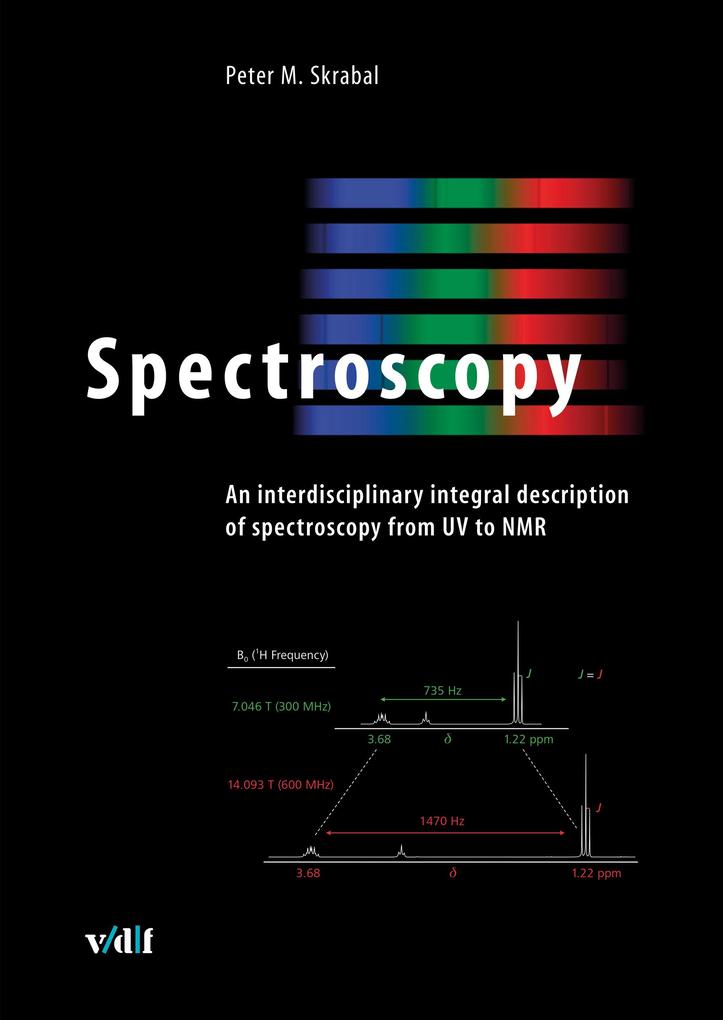
Sofort lieferbar (Download)
This book provides a novel view of spectroscopic methods: it describes spectroscopy holistically in terms of integral physical aspects instead of the classical methodic order according to wavelengths. The book introduces the reader to UV/Vis, NIR, IR, ESR, and NMR spectroscopy. These methods and their common physical basis, namely the reversible absorption of energy from the respective region of the electromagnetic spectrum, are illustrated in a comprehensive manner with the help of a multitude of explicative colored graphics.
Inhaltsverzeichnis
1;Cover;1 2;Dedication;3 3;Imprint;6 4;Preface;7 5;Foreword;9 6;Content;11 7;1 Introduction;13 7.1;1.1 Definitions and Systematics;13 7.2;1.2 Structure_Property Relations, Synthesis, and Process Planning;14 7.3;1.3 Development of Computers, Dynamics of Analytical Methods, and Process Control;18 7.4;1.4 Economic Significance of Analytical Methods;21 7.5;1.5 On the Conception of the Book;24 8;2 The Electromagnetic Spectrum;27 8.1;2.1 Its Regions and Present-Day Comprehension;27 8.2;2.2 The Instrumentation;33 9;3 The Absorption Processes and their Energies;43 9.1;3.1 The UV and Visible Region;45 9.2;3.2 The IR and Near IR (NIR) Region;54 9.3;3.3 The ESR Region;62 9.4;3.4 The NMR Region;71 9.5;3.5 A Comparative View;97 10;4 The Absorption Intensities: Prerequisites and Consequences;107 10.1;4.1 The UV and Visible Region;108 10.2;4.2 The IR and Near IR (NIR) Region;117 10.3;4.3 The ESR Region;122 10.4;4.4 The NMR Region;124 10.5;4.5 A Comparative View;136 11;5 Spectroscopy of Analytes in the four Phases;143 11.1;5.1 The Gas Phase;144 11.2;5.2 The Liquid Phase;145 11.3;5.3 Liquid Crystalline Phases;148 11.4;5.4 Solid-State Phases;151 11.5;5.5 Sample Preparation and Sample Purity;169 11.6;5.6 Internal and External Standards;177 12;6 The Measuring Techniques: CW and FT Spectroscopy;181 12.1;6.1 CW Spectroscopy;181 12.2;6.2 FT Spectroscopy;185 13;7 Spectroscopy in Two and Three Dimensions;199 13.1;7.1 1D Pulse Sequences in NMR Spectroscopy;200 13.2;7.2 Two-Dimensional (2D) and Three-Dimensional (3D)Spectroscopy;210 14;8 Application Areas and Limits;219 14.1;8.1 Structure Analyses;220 14.1.1;8.1.1 The Positions of Absorption Bands;221 14.1.2;8.1.2 Scalar Couplings, NOEs, and Relaxation Times;251 14.1.3;8.1.3 Solid-State Spectroscopy;267 14.1.4;8.1.4 Two- and Three-Dimensional Spectroscopy;277 14.2;8.2 Concentration and Kinetic Measurements;283 14.3;8.3 Dynamic Aspects;296 14.4;8.4 Diffusion Measurements and Imaging Spectroscopy;306 14.5;8.5 Opt(r)odes and Sensors, Tandem or C
ombined Methods;317 14.6;8.6 Chemometry;320 15;9 The Communication of Spectroscopic Data;323 16;10 Literature;329 16.1;10.1 A Selection of Textbooks and Standard Works;329 16.2;10.2 My Favorite Books;330 17;Addendum;331 18;Acronym, Name, and Keyword Index;337
ombined Methods;317 14.6;8.6 Chemometry;320 15;9 The Communication of Spectroscopic Data;323 16;10 Literature;329 16.1;10.1 A Selection of Textbooks and Standard Works;329 16.2;10.2 My Favorite Books;330 17;Addendum;331 18;Acronym, Name, and Keyword Index;337
Produktdetails
Erscheinungsdatum
01. Januar 2012
Sprache
englisch
Seitenanzahl
353
Dateigröße
5,77 MB
Autor/Autorin
Peter M. Skrabal
Verlag/Hersteller
Kopierschutz
mit Wasserzeichen versehen
Produktart
EBOOK
Dateiformat
PDF
ISBN
9783728133854
Entdecken Sie mehr
Bewertungen
0 Bewertungen
Es wurden noch keine Bewertungen abgegeben. Schreiben Sie die erste Bewertung zu "Spectroscopy" und helfen Sie damit anderen bei der Kaufentscheidung.







